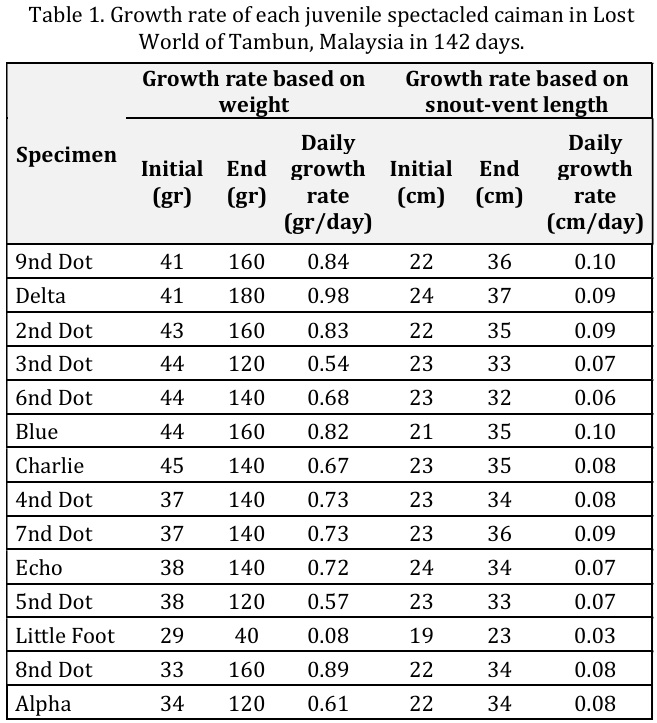The growth in juvenile spectacled caimans at The Lost World of Tambun Malaysia
Abstract
The spectacled caiman needs to be better studied, and its basic life history needs to be explored. Growth rates and changes in growth with age and size are essential life history characteristics. This study aimed to determine the growth rate of juvenile spectacled caimans in captivity and understand the factors that affect the growth rate of juvenile spectacled caimans. Fourteen juvenile spectacled caimans were used in the present study. The study shows that the growth rate of all the juvenile spectacled caimans varied, where specimens such as Delta and 9th Dot had the highest growth rate in terms of weight at 0.98 g/day and 0.89g/day, respectively. However, Little Foot had the lowest growth rates in snout-vent length and weight parameters at 0.03 cm/day and 0.08 cm/day. This study shows that the growth rate of juvenile spectacled caimans that dominance has a strong effect on the growth rate of juvenile spectacled caimans in captivity. Other factors that could be affected were social behavior, feeding behavior, and natural selection.
Downloads
References
Andrews RM. 1982. Chapter 6. Pattern of growth in reptiles. In: Gans C, Pough FH, eds. (1982). Biology of the Reptilia. Vol. 13. Academic Press, New York. pp 273-320.
Barragán-Contreras LA, Antelo R, Amézquita A. 2021. Not only big bulls-Correlation between morphometry, reproductive success, and testosterone level in a flooded savannah population of the Spectacled Caiman (Caiman crocodilus). Canadian Journal of Zoology. 99(7):580-587. https://doi.org/10.1139/cjz-2020-0099
Da Silveira R, Campos Z, Thorbjarnarson J, Magnusson WE. 2013. Growth rates of black caiman (Melanosuchus niger) and spectacled caiman (Caiman crocodilus) from two different Amazonian flooded habitats. Amphibia-Reptilia. 34(4):437-449. https://doi.org/10.1163/15685381-00002896
Endler JA. 1986. Natural Selection in the wild. Princeton Univ Press. Princeton. New Jersey (NJ)
Loveridge JP. 1984. Thermoregulation of the Nile crocodile Crocodylus niloticus. Symposia of the Zoological Society of London. 52:443-467.
Marques TS, Bassetti LA, Lara NR, Portelinha TC, Piña CI, Verdade LM. 2020. Home range and movement pattern of the broad-snouted caiman (Caiman latirostris) in a silviculture dominated landscape. South American Journal of Herpetology. 16(1):16-25. https://doi.org/10.2994/SAJH-D-18-00052.1
Reber SA, Oh J, Janisch J, Stevenson C, Foggett S, Wilkinson A. 2021. Early life differences in behavioral predispositions in two Alligatoridae species. Animal Cognition. 24(4):753-764. https://doi.org/10.1007/s10071-020-01461-5 | PMid:33454828 PMCid:PMC8238711
Schaller GB, Crawshaw PG. 1982. Fishing behaviour of Paraguayan caiman (Caiman crocodilus). Copeia. 1982:66-72. https://doi.org/10.2307/1444269
Stubbs TL, Pierce SE, Elsler A, Anderson PS, Rayfield EJ, Benton MJ. 2021. Ecological opportunity and the rise and fall of crocodylo-morph evolutionary innovation. Proceedings of the Royal Society B. 288(1947):20210069. https://doi.org/10.1098/rspb.2021.0069 | PMid:33757349 PMCid:PMC8059953
Soria-Ortiz G, Charruau P, Reynoso V. 2020. Variation in diet of hatchlings, juveniles and sub-adults of caiman Crocodylus chiapasius in La encrucijada, Chiapas, Mexico. Revista Mexicana De Biodiversidad. 91(0):e912852. https://doi.org/10.22201/ib.20078706e.2020.91.2852
Taylor JA. 1979. The foods and feeding habits of subadult Crocodylus porosus Schneider in Northern Australia. Australian Wildlife Research. 6(3):347-360. https://doi.org/10.1071/WR9790347
Thorbjarnarson JB. 1993. Diet of the spectacled caiman (Caiman crocodilus) in the Central Venezuelan Llanos. Herpetologica. 49(1):108-117. https://doi.org/10.2307/1447104

Copyright (c) 2024 CC-BY-SA

This work is licensed under a Creative Commons Attribution-ShareAlike 4.0 International License.
Authors who publish with this journal agree to the following terms:
1. Authors retain copyright and grant the journal right of first publication with the work simultaneously licensed under a Creative Commons Attribution License that allows others to share the work with an acknowledgement of the work's authorship and initial publication in this journal.
2. Authors are able to enter into separate, additional contractual arrangements for the non-exclusive distribution of the journal's published version of the work (e.g., post it to an institutional repository or publish it in a book), with an acknowledgement of its initial publication in this journal.
3. Authors are permitted and encouraged to post their work online (e.g., in institutional repositories or on their website) prior to and during the submission process, as it can lead to productive exchanges, as well as earlier and greater citation of published work (See The Effect of Open Access).

.jpg)















